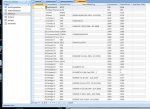Hi, i'm new here and I know there's a lot going on but i was hoping someone could point me in the right direction or give me a few tips...
I've imported a very large (nearly 15000 records) set of data into an Access database as one big huge table storing various bits of information about coins. As far as I can tell, the data is in at least first normal form, in that no multiple values are stored in any columns (not yet sure of the technical term - field?)
Anyway, I've managed to use a make table query to separate out some of the content of the table into separate tables with relating entities.
One question is, and please bear with me - How do I add an autonumbered primary key to these newly separated out tables and then add these autonumbered items to the original tables as IDs so that I can set up relationships? Is there a "proper" way to go about describing this?
The following consists of ALL the fields in the original table and how i've split them up by table:
STOCK
Group
ItemNo
ListNo
TypeCode
ActualDate
SortDate
CostPrice
SalePrice
Estimate
StockLevel
DateEntered
DateSold
Archived
Ref1
Ref2
Picture
Description
Cats
DenomCode
TypeCode
PeriodCode
ArchiveWhenSold
NotForSale
KeepSold
StockItem
Highlight
OnLists
OnWeb
Proof
DENOMINATIONS
DenomName
DenomCode
DenomHeading
DenomValue
PERIODS
PeriodName
PeriodCode
PeriodHeading
PeriodStartYear
PeriodEndYear
VARIETIES
Variety
The Variety field in the Variety table is especially problematic. There were 1259 varieties stored in the original table which are now in a separate Varieties table which is great. But how do i now add an autoincrement number and call it, say, VarietyID, but then link each Variety back to the main list of coins but replace the full Variety description with the newly created VarietyID?
If any of that made sense, i'd REALLY appreciate some wisdom here.
Thanks
I've imported a very large (nearly 15000 records) set of data into an Access database as one big huge table storing various bits of information about coins. As far as I can tell, the data is in at least first normal form, in that no multiple values are stored in any columns (not yet sure of the technical term - field?)
Anyway, I've managed to use a make table query to separate out some of the content of the table into separate tables with relating entities.
One question is, and please bear with me - How do I add an autonumbered primary key to these newly separated out tables and then add these autonumbered items to the original tables as IDs so that I can set up relationships? Is there a "proper" way to go about describing this?
The following consists of ALL the fields in the original table and how i've split them up by table:
STOCK
Group
ItemNo
ListNo
TypeCode
ActualDate
SortDate
CostPrice
SalePrice
Estimate
StockLevel
DateEntered
DateSold
Archived
Ref1
Ref2
Picture
Description
Cats
DenomCode
TypeCode
PeriodCode
ArchiveWhenSold
NotForSale
KeepSold
StockItem
Highlight
OnLists
OnWeb
Proof
DENOMINATIONS
DenomName
DenomCode
DenomHeading
DenomValue
PERIODS
PeriodName
PeriodCode
PeriodHeading
PeriodStartYear
PeriodEndYear
VARIETIES
Variety
The Variety field in the Variety table is especially problematic. There were 1259 varieties stored in the original table which are now in a separate Varieties table which is great. But how do i now add an autoincrement number and call it, say, VarietyID, but then link each Variety back to the main list of coins but replace the full Variety description with the newly created VarietyID?
If any of that made sense, i'd REALLY appreciate some wisdom here.
Thanks

